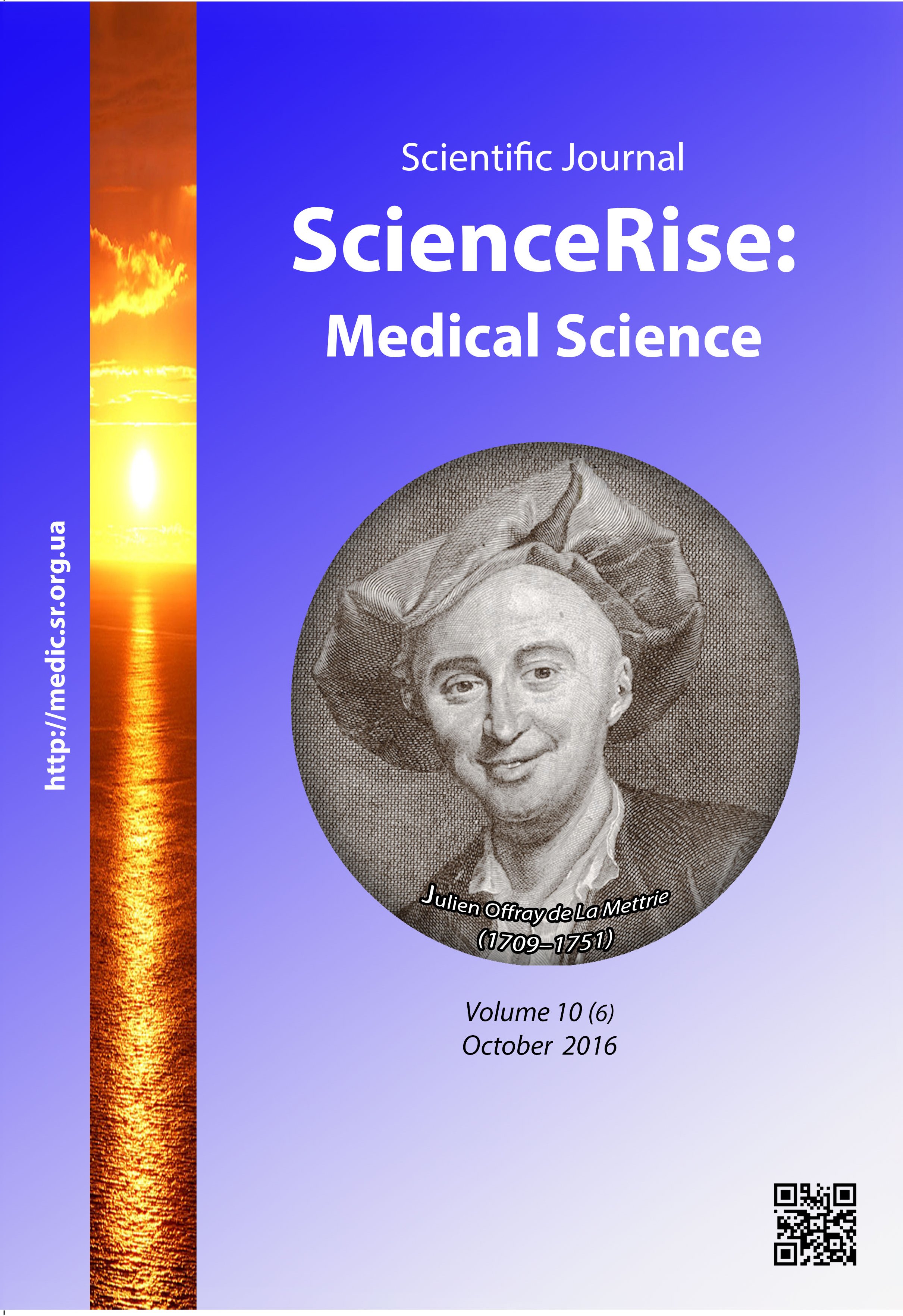The features of the initial vegetative tone in patients with vertigo
DOI:
https://doi.org/10.15587/2519-4798.2016.80619Keywords:
initial vegetative tone, vertigo, neurological patients, vegetative disordersAbstract
Vegetative dysfunction is most often manifested as vertigo. The presence of vestibular dysfunction on the background of vegetovascular dystonia is conditioned by the close functional connection between vestibular and vegetative nervous system.
The study of interaction and mutual connection between vertigo and vegetative functioning is necessary to improve the effectiveness of diagnostic and treating-rehabilitative arrangements.
Methods. 159 patients with vertigo were examined according to the scheme for revelation of the signs of vegetative disorders. All patients were divided in four groups, taking into account the cause of vertigo. The first group included 47 patients with acute ischemia of brain in vertebrobrasilar basin. The second one included 30 patients with craniovertebral pathology and vascular anomalies of the neck part. The third one – 40 patients with the injury of peripheral vestibular analyze, the fourth group – 42 patients with psychogenic vertigo.
Results. The analysis of parameters of VNS functioning in examined patients testified to the intrasystemic dysregulation; decrease of reserve possibilities of VNS adaptation, manifestations of the disorders of cerebral homeostasis and disturbance of the correct functioning of non-specific cerebral systems.
Conclusions. The interconnection between vertigo and central mechanisms of vegetative regulation that must be considered as the components of rehabilitative potential was revealed. These regularities can be the base for using integration approach in the choice of rehabilitative interventions at vertigo in patients with neurological pathology
References
- Günther, A., Salzmann, I., Nowack, S., Schwab, M., Surber, R., Hoyer, H. et. al. (2011). Heart rate variability – a potential early marker of sub-acute post-stroke infections. Acta Neurologica Scandinavica, 126 (3), 189–196. doi: 10.1111/j.1600-0404.2011.01626.x
- Lager, K. E., Mistri, A. K., Khunti, K., Haunton, V. J., Sett, A. K., Wilson, A. D. (2014). Interventions for improving modifiable risk factor control in the secondary prevention of stroke. Cochrane Database Syst. Rev., 2. doi: 10.1002/14651858.cd009103.pub2
- Blagoveshenskaya, N. S. (1990). Othoneurological symptoms and syndromes. Moscow: Medicine, 432.
- Vein, A. M. (Ed.) (2000). Vegetative disorders: symptoms, diagnostics, treatment. Moscow: Medical information agency, 752.
- Parfyonov, V. A., Zamergrad, M. V., Melnikov, O. A. (2011). Vertigo: diagnostics and treatment, common diagnostic mistakes. Moscow: Medical information agency, 192.
- Von Brevern, M., Süßmilch, S., Zeise, D. (2014). Acute vertigo due to hemispheric stroke. Journal of the Neurological Sciences, 339 (1-2), 153–156. doi: 10.1016/j.jns.2014.02.005
- Park, K. M., Shin, K. J., Ha, S. Y., Park, J., Kim, S. E. (2014). Isolated Rotational Vertigo Due to Internal Capsular Infarction. Journal of Neuro-Ophthalmology, 34 (1), 61–63. doi: 10.1097/wno.0000000000000088
- De Sarro, G., Mazzitello, C., Mumoli, L., Palleria, C., Aiello, R., Altomonte, M. et. al. (2013). Vertigo/dizziness as a Drugs′ adverse reaction. Journal of Pharmacology and Pharmacotherapeutics, 4 (5), 104. doi: 10.4103/0976-500x.120969
- Alekseeva, N. S. (2009). Ischemic cochleovestibular syndromes. Cure doctor, 7, 36–45.
- Yavorskaya, V. A., Hvisuk, V. V., Bondar, O. B. et. al. (2015). Clinical and pathomorphological matching of different types of the ischemic stroke. Ukrainian bulletin of the psychoneurology, 23 (3), 53–57.
- Kornilova, L. N., Ekimovskiy, G. A., Habarova, E. V., Glukhikh, D. O., Naumov, I. A., Sagalovitch, V. N. et. al. (2015). Computerized method of objectification of dizziness and vertigo and differential diagnostic of vestibulopathies. Zhurnal Nevrologii i Psikhiatrii Im. S. S. Korsakova, 115 (3), 54. doi: 10.17116/jnevro20151153154-60
- Kosyvcova, O. V., Zamergrad, M. V. (2012). Vertigo in the neurological practice (common questions of the diagnostics and treatment). Neurology, neuropsychiatry, psychosomatics, 1, 48–52.
- Morozova, O. G. (2007). Algorithm of the diagnostics and treatment in vertigo. Health of the Ukraine 21 century, 23, 49–52.
- Golubev, V. L. (Ed.) (2010). Vegetative disorders: symptoms, diagnostics, treatment. Moscow, 637.
Downloads
Published
How to Cite
Issue
Section
License
Copyright (c) 2016 Світлана Валеріївна Федорченко

This work is licensed under a Creative Commons Attribution 4.0 International License.
Our journal abides by the Creative Commons CC BY copyright rights and permissions for open access journals.
Authors, who are published in this journal, agree to the following conditions:
1. The authors reserve the right to authorship of the work and pass the first publication right of this work to the journal under the terms of a Creative Commons CC BY, which allows others to freely distribute the published research with the obligatory reference to the authors of the original work and the first publication of the work in this journal.
2. The authors have the right to conclude separate supplement agreements that relate to non-exclusive work distribution in the form in which it has been published by the journal (for example, to upload the work to the online storage of the journal or publish it as part of a monograph), provided that the reference to the first publication of the work in this journal is included.









